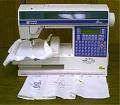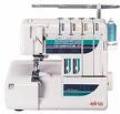
 |
 |
 |
 |
Sewing Embroidry Reviews
Embroidery 101 An Overview And History
Embroidery 101 an Overview and History
The art of embroidery has been practiced in one form or another throughout the ages. Embroidery is simply specific as thread embellishment on cloth. Practically as long as there has existed cloth, there has existed embroidery.
Some of the most famous civilizations for creating brilliant embroidery creations are the Japanese and the English. They both used embroidery to decorate ceremonial garments as wrapped tight as decorative home items. While the Japanese are most admitted for their amazing kimonos, the English are well known for their hand embroidered fabric furniture panels.
Unfortunately for collectors, many of the works of embroidery art of the past have been lost to time and decay. The silk threads and fabrics are very prone to damage by insects and light. It is very unlikely these days to find a task made prior to the mid 1600ís. Examples from earlier than this time individual exist in museums, and churches who have taken the care to restore and preserve them.
There are two major forms of embroidery from the past which are collected today; they are: stump work and samplers.
Stump work was made in the mid - seventeenth century and consists of a highly colored, embroidered design on white silk. Often the works are done of scenes of people and carved wooden heads, hands and feet are added to these works of art. Often found with head work are padded areas which are used to make the designs three dimensional and interesting to the eye.
Stump work was made to depict scenes of live at the time and was used to cover mirror frames, and to take cover trinket boxes. These trinket boxes were often made with many small drawers and with secret compartments for hiding valuables such as tea and jewelry. Often the trinket boxes contained mirrors and were lined with paper and metallic tapes.
Serious collectors today are still discovering wonderful stump work to add to their collections.
In the past, as part of the regular school curriculum of girls, embroidery was taught. These very young students, sometimes as young as seven or eight years old, would show their sewing skills by creating colorful samplers. The samplers would showcase their sewing skills as well as their knowledge of the numbers and alphabets. Many samplers were created which narrate the children, their interests and their school buildings as well. Samplers were generally stitched on wool or silk fabrics with very colorful silk and metallic threads and can still be found for purchase today. Very old or very decorative samplers today are worth a cluster of money to the collectors who are fortunate enough to own them.
Some of the most unusual embroidery throughout the times has been that of maps. Maps were drawn on silk and then stitched. The names of countries and other places of interest were stitched on the maps.
If you have ever tried any form of hand embroidery, you know it is a slow and tedious process. The impression are amazing, but it can take a very long ticks to achieve even the simplest of designs. This makes all embroidered fabrics from the past very collectable today by those who understand all of the hours and patience which went into creating the works of art. While descendants around the world no longer do embroidery as part of their school curriculum, the art is still practiced by adults all over the globe.
 |
 |
 |
Using Embroidery To Enhance Your Scrapbook Pages
Avoiding Hand And Wrist Injuries While Embroidering
Sewing Tips For Every Beginner
Beginning Cross Stitch Embroidery Tips
Teaching Sewing As A Viable Home Business
Designing Your Own Cross Stitch Embroidery Patterns
PDA
Physiotherapy
Property Taxes
Renting
Security Cameras
Seniors Issues
Weather
Web Video
More Sewing Embroidry Reviews
... towering - haul, you will need to follow some time - tested home business strategies. Let s revenue a moment to briefly look at each of them: The Business Plan No matter what business you decide to start, you 100 % have to have a solid business plan. There is no way possible to have a successful business ...
... pile or delicate fabrics. By utilizing this type of closure you can balm to assure the fabric consign not get trapped in the zipper teeth and ruined. A lapped zipper is located under a incomparable flap of fabric. There is unrivaled one line of stitching you can see from the outside of the garment. Lapped ...
The Latest Trend In Embroidery
... you insert them through the paper. For this reason, you want to first-rate threads which are smooth and not bulky. By choosing smooth threads they will not fray as you tug them over the paper, and your final design will flash much crisper and detergent. Metallic embroidery threads are now readily available ...
... with popping pins and diagonal pulls as you sew in the elastic. Again, using a wide, far-off erratic stitch, to allow for the elastic to move and shape your project, and stretch your elastic and sew the top of it into place. Continue to sew around the top of the elastic and in consequence move on to sewing ...

|
| Copyright © 2006-2012 Internet Marketing Tools, All Rights Reserved |